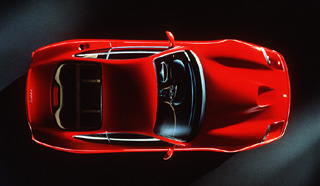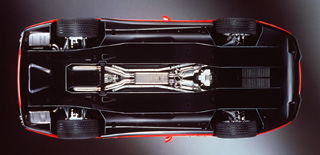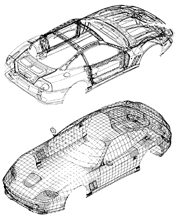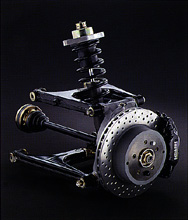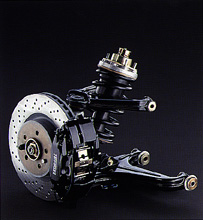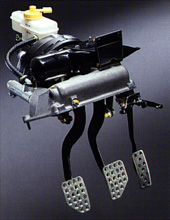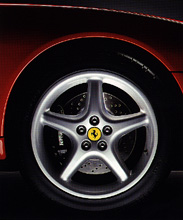|
|
|
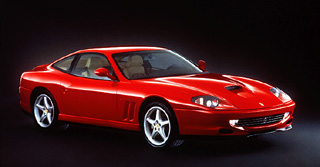
|
AT THE ORIGIN OF PERFORMANCE
Aerodynamics and its values The 550 maranello is a creature of the wind tunnel. Its aerodynamic shape is the result of hard work that needed 4,800 hours of wind tunnel tests to achieve the targets set by the project, which consisted of:
The 550 maranello is another step forward in the aerodynamic development of the car underbody, which has led to excellent stabilistrucuturety and driving safety. The vertical load independent of set-up and a Cz lower than nought are a unique result for a car with no mobile parts or added aerodynamic surfaces. Particular care went into the design of the front of the car with its characteristics groove, the aerodynamic efficiency of the air intakes, and the interior air flows. Styling decision 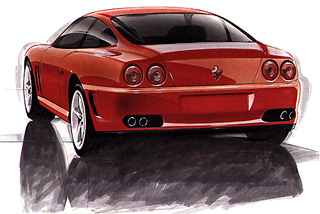
Pininfarina has designed a body with characteristically extreme proportions for this return to a front engine on Ferrari's top performance berlinetta: low and wide, with a large bonnet and cut-off tail, features that immediately give the impression of a great sports car. To do this Pininfarina used only the following requirements:
The design of the 550 Maranello is fast and sinewy, with marked dihedrons that stretch the soft surfaces of the sheet metal, creating strong characteristics signs from whatever angle you view the car. The volumes are clean and frank, not smoothed or tapered, so that the car's physical presence underlines its performance. The roof is unusually light for a Ferrari, with fine pillars that make it less obvious visually and stress the importance of the car body by contrast, the structure housing the mechanicals, which are the heart and soul of the 550 maranello and lower the optical centre of gravity. The front has several original elements: the air intake is positioned very low down and has a narrow shape, incorporating the foglights at either end. The lower edge has a complex, modelled shape that creates an aggressive play of lights. The air intake for the fuel feed is positioned at the centre of the large bonnet, an engineering requrement that links the present to the past. This is the first Ferrari to have been conceived and designed from the start with visible light clusters, integrated in the shape of the bodywork. The side is highlighted at the top by a dihedron that gives it force and dynamism, forming a string, personal motif that emphasises the rear wing. The relationship between the long bonnet and the small rear cabin, and the smooth link with the high tail, are typical of Ferrari. Two outlets for the engine bay air have been created in the large front wing, between the wheelarch and the door, close obligatory reference to the classic front-engined berlinettas. The rear is simple and powerful: it is higher in the middle where it links up to the roof with a small spoiler, and lower around the wings; the double round lights are characteristics of Ferrari car design. This apparently natural, spontaneous shape is, like the front spoiler in particular and more generally the whole of the 550 maranello, the fruit of work to integrate styling and aerodynamics. Bodywork In addition to the aerodynamic features mentioned above, the body work is distinguished by technical apertures typical of Ferrari styling at the points of greatest efficiency. Fixed homofocal front light clusters were designed for this model, and they were incorporated in the bonnet to improve the Cd and wind noise during night driving. The foglights are incorporated into the front bumper. The door windows are flush with the body work, and fitted with an automatic opening/closing device that is activated when the doors are opened or closed for better all-round sealing. The efficient frame 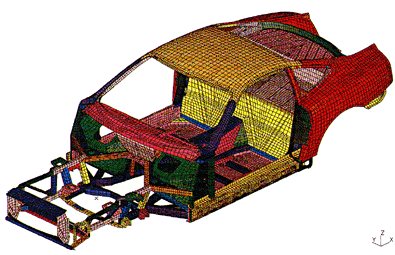
The frame of the 550 maranello, is built of high tensile welded steel tubes, with a variable section to optimise the weight. Torsional rigidity is 1500 kgm/degrees, and flexional rigidity is 800 kg/mm. The Ferrari frame has the constructional simplicity that comes from many years of experience in building racing cars. Simplicity and structural discipline combined with extremely stable performance in time produce an excellent result for vehicles with a strong sports temperament destined for production in limited numbers. All this guarantees total engineering safety in terms of structure, and the reliability of engine, transmission, suspension, steering and brakes anchorage. The safety features are outstanding, particularly with regard to the central cage which is very strong and protected by peripheral elements which constitute a system with high energy absorption. Such high safety standards are a must for a company like Ferrari, which exports over 85% of its production to foreign markets, which means that the strictest safety standards must be met. Dimensions and weights
Suspensions and non-suspended masses
The 550 maranello has independent suspension on all four wheels with transverse parallelogram structure and triangular arms, aluminium gas dampers with coaxial coil springs and anti-roll bars on the front and rear axles. Constant set-up adjustment
The damping logic changes inside each range, depending on speed and taking into account vertical acceleration, the steering angle, the throttle valve angle and brake circuit pressure. The same system controls car pitching during transients. The front track is wider than the rear to guarantee prompt turn-in to corners, and the structure of the front axle is designed to ensure an antidive effect when braking. The braking system A car's performance is determined not only by its acceleration and stability but also by the quality if its deceleration. Ferrari developed the braking system of the 550 maranello jointly with Brembo, applying methods borrowed from Formula 1. The system is structured as follows:
The car's outstanding performance also made it necessary to develop pistons for the front calipers with special thermal insulation devices, that exploit concepts tested by Brembo on Formula 1 Ferraris in recent seasons. This made it possible to keep the brake fluid temperature at a very good level, even in difficult conditions. The excellent performance of the braking system is enhanced by the drilled discs, which ensure better grip, even in wet weather, because they burst the film of water when the pad comes into contact with the braking surface. Continuous refinement of all the components of the braking system ensures prompt braking and shortens the braking distance in all situations. The system is completed by a four-channel ABS incorporating electronic brake effort proportioning which guarantees ideal performance in deceleration above 0.5 g. The whole system was produced taking particular care to limit the weight of the complete assembly. ASR, drive control system The system prevents the driven wheels from spinning by the combined action of the rear brakes and the engine management system, which it communicates with a CAN line. The system adopted by the Ferrari 550 maranello is the only one to offer a choice of two operating levels, selected manually by a switch on the facia:
Depending on which mode is selected, the system intervenes by cutting off the torque delivered by the engine, or, co-ordinated by the ABS system, by braking the two rear wheels independently. In other words, it is the first active anti-wheel spin system which the driver is able to control. The normal/sport selection of the ASR system coincides with selection of the function level of the suspension (one switch governs both selections), giving the driver total control of lateral and longitudinal dynamics of the car. Speed-sensitive power steering The ZF rack and pinion steering system comes complete with the Servotronic speed-sensitive power steering device which varies in relation to the speed the level of power assist, in order to adapt steering wheel response to different operating conditions. The direct steering ratio is 13.8:1, while the turning circle is 39.3 ft. Wheels
The choice of diameters was decided by the need to fit large brake discs and low profile tyres. As a result, the front wheel 24.9 lb, a 25% reduction on standard values. The wheel has passed both Ferrari's own severe tests and those of the German LBF Technical Institute (duration at least 300.000 km). Each wheel is protected by a special cycle of anti-corrosion paint patented by Speedline. Tyres and fuel tank For the first time on a production car, the tyres were designed with the car. Having set a target for the car's performance level, the frame, suspension and tyres were developed in parallel deciding the characteristics of each subsystem, including the tyres, and optimising performance on the basis of the final result. The 550 maranello has homologated four different types of tyres, all produced specially for this car. Each manufacturer has given a particular interpretation to the brief, based on specific experience in racing and long-standing co-operation with Ferrari. The homologated tyres have the following measurements: front: 255/40 ZR 18; rear: 295/35 ZR 18; and are: Bridgestone Expedia S02, GoodYear Eagle GS Fiorano, Pirelli P Zero, Michelin MXX 3 Pilot (front tyres 235/45 ZR 18). The fuel tank is in light aluminium alloy and holds 30 US gal. The fuel pumps are of the immersed type. The tank is in a protected position in front of the rear axle, underneath the car. The horsepower and how it is controlled |

